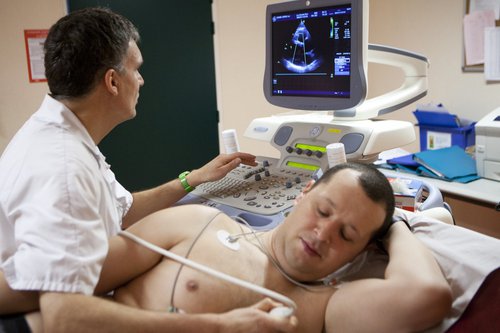An echocardiogram, or "echo", is a scan used to look at the heart and nearby blood vessels.
It's a type of ultrasound scan. A small probe sends out high-frequency sound waves. These create echoes when they bounce off different parts of the body.
The probe picks up these echoes and turns them into a moving image on a monitor while the scan is carried out.
A heart specialist (cardiologist) or any doctor may request an echocardiogram. They will do this if they think that you might have a problem with your heart.
The test will take place at a hospital or clinic. A cardiologist or a trained specialist usually carries out the test.
Although it has a similar name, an echocardiogram is not the same as an electrocardiogram (ECG). An ECG is a test used to check your heart's rhythm and electrical activity.
When an echocardiogram is used
An echocardiogram can help diagnose and check certain heart conditions. It does this by checking the structure of the heart and surrounding blood vessels. It analyses how blood flows through them and assesses the pumping chambers of the heart.
An echocardiogram can help detect:
- damage from a heart attack – where the supply of blood to the heart was suddenly blocked
- heart failure – where the heart fails to pump enough blood around the body at the right pressure
- congenital heart disease – birth defects that affect the normal workings of the heart
- problems with the heart valves – problems affecting the valves that control the flow of blood within the heart
- cardiomyopathy – where the heart walls become thickened or enlarged
- endocarditis – an infection of the heart valves
An echocardiogram can help your doctors decide the best treatment for these conditions.
How an echocardiogram is carried out
There are several different ways an echocardiogram can be carried out. Most people will have a transthoracic echocardiogram (TTE). This procedure is outlined below.
You will not usually need to do anything to prepare for the test, unless you're having a transoesophageal echocardiogram.
Transthoracic echocardiogram

For a TTE, you'll be asked to remove any clothing covering your upper half before lying down on a bed. You may be offered a hospital gown to cover yourself during the test.
Several small sticky sensors called electrodes will be attached to your chest. These will be connected to a machine that monitors your heart rhythm during the test.
A lubricating gel will be applied to your chest or directly to the ultrasound probe. You'll be asked to lie on your left side and the probe will be moved across your chest.
The probe is attached by a cable to a nearby machine that will display and record the images produced.
You will not hear the sound waves produced by the probe, but you may hear a swishing noise during the scan. This is normal and is just the sound of the blood flow through your heart being picked up by the probe.
The whole procedure will usually take between 15 and 60 minutes. You'll be able to go home shortly afterwards.
Other types of echocardiogram
There are also several other types of echocardiogram that can be carried out.
The type of echocardiogram you will have depends on the heart condition being assessed and how detailed the images need to be.
For example, a stress echocardiogram may be recommended if your heart problem is triggered by physical activity. But the more detailed images produced by a Transoesophageal echocardiogram (TOE) may be more useful in helping plan heart surgery.
Transoesophageal echocardiogram (TOE)
This is where a small probe is passed down the throat into your gullet and stomach. Your throat will be numbed with local anaesthetic spray and you'll be given a sedative to help you relax.
You may need to avoid eating for several hours before this test
Stress echocardiogram
This is carried out during or just after a period of exercise on a treadmill or exercise bike. It may also be carried out after you have an injection of a medication that makes your heart work harder
Contrast echocardiogram
This is where a harmless substance called a contrast agent is injected into your bloodstream. This substance shows up clearly on the scan and can help create a better image of your heart
Getting your results
The scan will usually need to be analysed before the results are sent to the doctor who requested the test. Your doctor will then discuss the results with you during your next appointment.
Risks or side effects
A standard echocardiogram is a simple, painless, safe procedure. There are no side effects from the scan, although the lubricating gel may feel cold. You may feel some minor discomfort when the electrodes are removed from your skin at the end of the test.
There are some risks associated with the less common types of echocardiogram.
You may find the TOE procedure uncomfortable. Your throat may feel sore for a few hours afterwards. You will not be able to drive for 24 hours after the test as you may still feel drowsy from the sedative. There's also a small chance of the probe damaging your throat.
During a stress echocardiogram, you may feel sick and dizzy. You may experience some chest pain. There's also a small chance of the procedure triggering an irregular heartbeat or heart attack. You'll be monitored during the test and it will be stopped if there are signs of any problems.
Some people have a reaction to the contrast agent used during a contrast echocardiogram. This will often only cause mild symptoms such as itching.
Content supplied by the NHS and adapted for Ireland by the HSE
